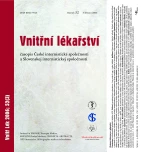Extension of QT interval as a consequence of risk factor accumulation – case study
Authors:
M. Šišáková 1; O. Toman 1; A. Floriánová 1; J. Kadlecová 2; K. Chroust 3; I. Papoušek 3; J. Špinar 1
Authors‘ workplace:
Interní kardiologická klinika Lékařské fakulty MU a FN Brno, pracoviště Bohunice, přednosta prof. MUDr. Jindřich Špinar, CSc., FESC
1; Oddělení lékařské genetiky FN Brno, pracoviště FDN J. G. Mendela, přednostka prim. MUDr. Renata Gaillyová
2; Katedra genetiky a molekulární biologie Přírodovědecké fakulty MU Brno, přednosta prof. RNDr. Jiří Doškař, CSc.
3
Published in:
Vnitř Lék 2006; 52(3): 271-273
Category:
Case Report
Overview
Background:
Many non-cardiovascular drugs have a potential for QT interval prolongation. This phenomenon can be related to occurence of ventricular tachycardia torsades de pointes, syncopi and even sudden death. Description of the case: A female patient treated with antracycline cytostatics developed a depression of left ventricle ejection fraction. At the same time she was administered 2 common drugs with proarrhythmic potential - terfenadine and itraconazole. In this patient hypokalemia also occured. Combination of the above mentioned risk factors led to QT interval prolongation and frequent ventricular tachycardias torsades de pointes degenerating in ventricular fibrillations with need of repeated defibrillations. Both drugs were withdrawn and dysiontaemia corrected. Then arrhythmias disappeared and QT interval completely normalized. In this patient the congenital long QT syndrome was not proved.
Discussion and conclusions:
In proarrhythmic effect of non-cardiovascular drugs the following factors play role: predisposition of a particular individual, „repolarization reserve“, interindividual differences in drug metabolism. The risk factors are age, sex, dysiontaemia, heart disease and drug interactions. By different choice of medication and attention to risk factors teh life threat to the described patient could have been avoided.
Key words:
proarrhythmia - QT interval prolongation - sudden death
Sources
1. Anderson ME, Al-Khatib SM, Roden DM et al. Cardiac repolarization: current knowledge, critical gaps, and new approaches to drug development and patient management. Am Heart J 2002; 144: 769-781.
2. Evans WE, McLeod HL. Pharmacogenomics - drug disposition, drug targets and side effects. N Engl J Med 2003; 348: 538-549.
3. Fenichel RR, Malik M, Antzelevitch C et al. Independent Academic Task Force. Drug-induced torsades de pointes and implications for drug development. J Cardiovasc Electrophysiol 2004; 15: 475-495.
4. Novotný T. Proarytmické účinky nekardiálních léků na podkladě prodloužení intervalu QT. Kardiol Prax 2004; 2: 119-122.
5. Novotný T, Kadlecová J, Papoušek I et al. Mutační analýza LQT genů u jedinců s polékovým prodloužením QT intervalu. Vnitř Lék 2006; 52: (rukopis).
6. Priori SP, Rivolta I, Napolitano C. Genetics of long QT, Brugada, and other channelopathies. In: Zipes DP, Jalife J. (eds). Cardiac electrophysiology: from cell to bedside. 4th ed. Philadelphia: WB Saunders 2004: 462-470.
7. Romano C, Gemme G, Pongiglione R. Aritmie rare dell´eta pediatrica. Clin Pediatr (Bologna) 1963; 45: 656-683.
8. Semrád B. Od selhání antiarytmik k pochopení fenoménu proarytmie. Vnitř Lék 2003; 49: 700-706.
9. Weinshilboum R. Inheritance and drug response. N Engl J Med 2003; 348: 529-537.
10. Zareba W, Lin AD. Antipsychotic drugs and QT interval prolongation. Psychiatr Q 2003; 74: 291-306.
Labels
Diabetology Endocrinology Internal medicineArticle was published in
Internal Medicine

2006 Issue 3
Most read in this issue
- Effect of administration of Escherichia coli Nissle (Mutaflor) on intestinal colonisation, endo-toxemia, liver function and minimal hepatic encephalopathy in patients with liver cirrhosis
- Extension of QT interval as a consequence of risk factor accumulation – case study
- Immunoglobulin A and renal diseases
- Non-invasive ventilation support in patients with acute exacerbation of chronic obstructive pulmonary disease (COPD)
